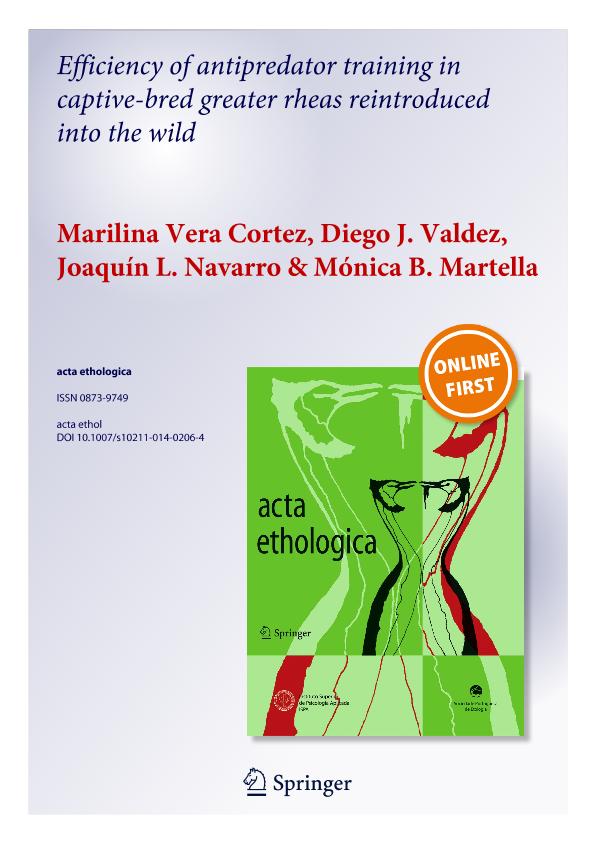Mostrar el registro sencillo del ítem
dc.contributor.author
Vera Cortez, Marilina

dc.contributor.author
Valdez, Diego Javier

dc.contributor.author
Navarro, Joaquin Luis

dc.contributor.author
Martella, Monica Beatriz

dc.date.available
2016-11-03T15:59:05Z
dc.date.issued
2015-03
dc.identifier.citation
Vera Cortez, Marilina; Valdez, Diego Javier; Navarro, Joaquin Luis; Martella, Monica Beatriz; Efficiency of antipredator training in captive-bred greater rheas reintroduced into the wild; Springer Heidelberg; Acta Ethologica; 18; 2; 3-2015; 187-195
dc.identifier.issn
0873-9749
dc.identifier.uri
http://hdl.handle.net/11336/7931
dc.description.abstract
High post-release mortality of captive greater rheas reintroduced into the wild might be mitigated with antipredator training that helps released individuals recognize their predators. We analyzed whether captive-bred greater rheas conserve antipredator behavior, and evaluated the efficiency of antipredator training by recording survival after reintroduction into the wild. Training involved 12 individuals and consisted of a stimulus representing the natural predator (taxidermized puma) paired to an aversive stimulus (simulated capture). The control stimulus consisted of an innocuous object (chair) that was not paired to the aversive stimulus. Thirty and 60 days after the last training session, we presented the trained and control individuals (nine untrained individuals) to the predator stimulus, which was not paired to the aversive one. All of the greater rheas showed vigilant and running behaviors in the presence of the predator model. Trained individuals did not discriminate between a predator and a non-predator stimulus but they recognized the predator up to 2 months later. Survival was nil 8 months after release. However, only one individual was killed by a puma, whereas the remaining individuals died due to dog attack and poaching. Training did not increase survival of reintroduced greater rheas because of the failure to consider other potential predators, such as dogs or humans. Therefore, captive breeding might have affected greater rheas? behavior by preventing them from recognizing man as a predator.
dc.format
application/pdf
dc.language.iso
eng
dc.publisher
Springer Heidelberg

dc.rights
info:eu-repo/semantics/openAccess
dc.rights.uri
https://creativecommons.org/licenses/by-nc-sa/2.5/ar/
dc.subject
Rhea Americana
dc.subject
Conservation
dc.subject
Antipredator Training Behavior
dc.subject
Reintroduction
dc.subject
Survival
dc.subject.classification
Zoología, Ornitología, Entomología, Etología

dc.subject.classification
Ciencias Biológicas

dc.subject.classification
CIENCIAS NATURALES Y EXACTAS

dc.title
Efficiency of antipredator training in captive-bred greater rheas reintroduced into the wild
dc.type
info:eu-repo/semantics/article
dc.type
info:ar-repo/semantics/artículo
dc.type
info:eu-repo/semantics/publishedVersion
dc.date.updated
2016-11-02T18:15:47Z
dc.journal.volume
18
dc.journal.number
2
dc.journal.pagination
187-195
dc.journal.pais
Alemania

dc.journal.ciudad
Heidelberg
dc.description.fil
Fil: Vera Cortez, Marilina. Consejo Nacional de Investigaciones Cientificas y Tecnicas. Centro Cientifico Tecnologico Cordoba. Instituto de Diversidad y Ecologia Animal; Argentina
dc.description.fil
Fil: Valdez, Diego Javier. Consejo Nacional de Investigaciones Cientificas y Tecnicas. Centro Cientifico Tecnologico Cordoba. Instituto de Diversidad y Ecologia Animal; Argentina
dc.description.fil
Fil: Navarro, Joaquin Luis. Consejo Nacional de Investigaciones Cientificas y Tecnicas. Centro Cientifico Tecnologico Cordoba. Instituto de Diversidad y Ecologia Animal; Argentina
dc.description.fil
Fil: Martella, Monica Beatriz. Consejo Nacional de Investigaciones Cientificas y Tecnicas. Centro Cientifico Tecnologico Cordoba. Instituto de Diversidad y Ecologia Animal; Argentina
dc.journal.title
Acta Ethologica

dc.relation.alternativeid
info:eu-repo/semantics/altIdentifier/url/http://link.springer.com/article/10.1007/s10211-014-0206-4
dc.relation.alternativeid
info:eu-repo/semantics/altIdentifier/doi/http://dx.doi.org/10.1007/s10211-014-0206-4
Archivos asociados
